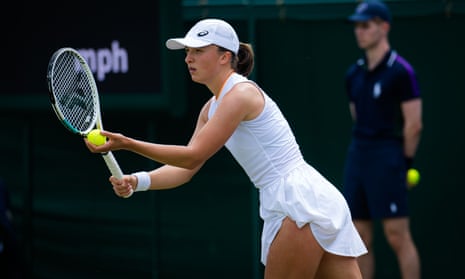Ernie Els used to say that to be a top golfer it helped if you were not the brightest spark, and the fewer thoughts going on in your head the better if you were standing over a crucial putt. For tennis players, too, quietening the mind to try to get in “the zone” is a coveted trait and for some that can be a problem.
There is a difference between being smart and quietening the mind, of course, as Roger Federer explained after his third-round win against Cameron Norrie at Wimbledon on Saturday. “I was sitting on the change of ends, it was just empty thoughts, no bad, no positive, just sitting there and relaxing. This is how I want it to be.”
Iga Swiatek shot to fame last October when she won the French Open title at the age of 19, playing brilliant tennis, seemingly unaffected by the pressure of the occasion. One of the best, smartest and most thoughtful players on tour, she is able to compartmentalise so that all the things she is doing to make herself a top player do not get in her way in the biggest moments.
In the fourth round on Monday, Swiatek plays Ons Jabeur, the Tunisian trailblazer and the first Arab woman to reach week two at Wimbledon. Jabeur’s variety, which includes a killer drop shot, helped her to win her first grass-court title in Birmingham last month and she presents a real test of Swiatek’s title credentials.
The junior champion at Wimbledon just three years ago, the No 7 seed Swiatek has talked about the work she does with a sports psychologist, Daria Abramowicz. But in this age of the “team”, Swiatek is also embracing the use of data, taking on board analysis from another expert to figure out how she can get the extra 1%-2% that could be the difference between being a top-five player and becoming world No 1.
Mike James is a specialist in tennis strategy and data analytics who has worked with several top players, including Stan Wawrinka. He has been part of Swiatek’s team since just after the French Open last year and working directly with her coach, Piotr Sierzputowski, he puts together statistics, backed up by video, to help her understand more about her game. It is then Sierzputowski’s job to simplify the data for Swiatek, with James estimating that around 20% of the data is passed on to her at any one time.
“Piot’s sitting down with Iga after every tournament and reviewing the numbers, reviewing the patterns,” James says. “And then they use that for the practice court, for the next tournament. At the moment we’re not scouting the opponents … what I like with Piot, his vision to begin with was, let’s use the data and the video to build her game and really monitor that all the way through.

“As a tennis coach, we only measure [success] by the ranking going up or down and winning or losing, whereas actually there’s a hidden amount of information behind that. He is really receptive and I think she’s taking [it] on board really, really well for the practice court. At the moment, she is going well.”
Since James made the switch to data analysis after 20 years as a coach, its use has snowballed in sport as a whole and, though tennis took time to catch up, the likes of the men’s world No 1 Novak Djokovic have incorporated statistical analysis into their games.
Players like to hear and see data in different ways; Victoria Azarenka wants to know everything while another former world No 1, Kim Clijsters, just wants to go out and play. Swiatek has embraced it, realising it can be an added tool in her increasingly impressive armoury, though she prefers to have it filtered first by Piotr.
“I’m the kind of person who needs someone who’s going to convert all the statistical information into good advice,” she says. “In other sports, it’sobvious that you’re using analytics to help you with some stuff. But in tennis it’s kind of new. I’m pretty happy that we started that. I think it’s good to have all the information that you can get, just to have more. I think it’s working pretty well.”
Swiatek’s game was on song in the first week, especially on serve, where she is in the top 10 in a number of categories. In the end, it comes down to how she produces on the day. But she is well prepared.
